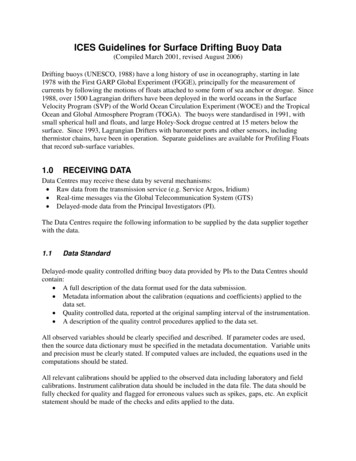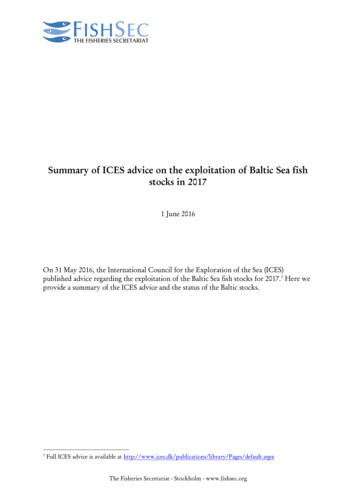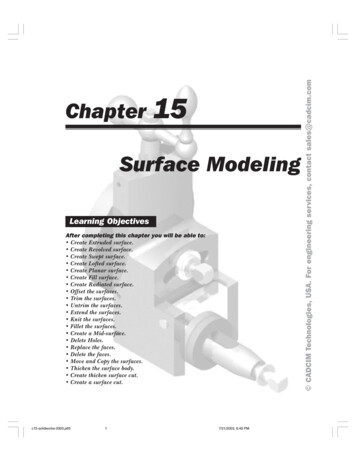
Transcription
ICES Guidelines for Surface Drifting Buoy Data(Compiled March 2001, revised August 2006)Drifting buoys (UNESCO, 1988) have a long history of use in oceanography, starting in late1978 with the First GARP Global Experiment (FGGE), principally for the measurement ofcurrents by following the motions of floats attached to some form of sea anchor or drogue. Since1988, over 1500 Lagrangian drifters have been deployed in the world oceans in the SurfaceVelocity Program (SVP) of the World Ocean Circulation Experiment (WOCE) and the TropicalOcean and Global Atmosphere Program (TOGA). The buoys were standardised in 1991, withsmall spherical hull and floats, and large Holey-Sock drogue centred at 15 meters below thesurface. Since 1993, Lagrangian Drifters with barometer ports and other sensors, includingthermistor chains, have been in operation. Separate guidelines are available for Profiling Floatsthat record sub-surface variables.1.0RECEIVING DATAData Centres may receive these data by several mechanisms: Raw data from the transmission service (e.g. Service Argos, Iridium) Real-time messages via the Global Telecommunication System (GTS) Delayed-mode data from the Principal Investigators (PI).The Data Centres require the following information to be supplied by the data supplier togetherwith the data.1.1Data StandardDelayed-mode quality controlled drifting buoy data provided by PIs to the Data Centres shouldcontain: A full description of the data format used for the data submission. Metadata information about the calibration (equations and coefficients) applied to thedata set. Quality controlled data, reported at the original sampling interval of the instrumentation. A description of the quality control procedures applied to the data set.All observed variables should be clearly specified and described. If parameter codes are used,then the source data dictionary must be specified in the metadata documentation. Variable unitsand precision must be clearly stated. If computed values are included, the equations used in thecomputations should be stated.All relevant calibrations should be applied to the observed data including laboratory and fieldcalibrations. Instrument calibration data should be included in the data file. The data should befully checked for quality and flagged for erroneous values such as spikes, gaps, etc. An explicitstatement should be made of the checks and edits applied to the data.
1.2Format DescriptionData Centres may receive drifting buoy messages in real-time coded formats transmitted on theGTS and in delayed-mode quality controlled drifting buoy data formats from PIs. The WMOcoded formats (WMO, 1995) used for GTS distribution of real-time drifting buoy messages areWMO FM 18-XII BUOY (ASCII), FM 94 BUFR (binary).The contents of the data and ancillary information should adhere to the Formatting Guidelinesfor Oceanographic Data Exchange http://ocean.ices.dk/formats/GETADE Guidelines.aspxprepared by IODE.The PIs data formats for the exchange of delayed-mode surface drifting buoy data set shouldinclude: A full description of the format used (preferably a fully documented ASCII format). The files should be homogeneous (i.e. each piece of information must always be in thesame place in the file). Individual fields and units should be clearly defined. Ideally all of the data from the instrument should be stored in a single file. All data values should be in SI units. Time reported in UTC is strongly recommended.1.3Collection DetailsDetails on the collection of drifting buoy data should always be included. Metadata such asWMO number, buoy type, drogue type etc are important for proper use and understanding of thedata. While the BUOY format can allow some extra data in real-time, BUFR can provide more.Refer to the drifting buoy BUFR template listed in 1.2 for the list of variables that should beincluded.Metadata requirements for delayed-mode quality controlled drifting buoy data provided by PIs tothe Data Centres include: Deployment platform name Country, organisation, Principal Investigator Project name Float number WMO number Sensor resolutions Information about the instruments and sensors (type and manufacturer, serial and modelnumbers, board type and serial number, software version) Information about the data precision and final accuracy.Any additional information of use to secondary users which may have affected the data or have abearing on its subsequent use should also be included.
2.0VALUE ADDED SERVICEWhen processing and quality controlling data, the Data Centres of the ICES community shallstrive to meet the following guidelines.2.1Quality ControlThe primary responsibility for data quality control lies with the PIs from which the observationsoriginate. In many cases, drifting buoy data originate from a national meteorological service, anoceanographic institute or a PI for a particular research project.Real-timeAll real-time drifting buoy data go through Service Argos to be distributed on to the GTS. PIsand other data centres and services carry out appropriate quality control of observationalmessages they receive. Automatic Quality Control (QC) checks can quickly detect erroneousmessages by comparing sensor data with constant limits.VariableLower limitUpper limitSea level air pressure (hPa)8001080Station air pressure (hPa)4001080Air pressure tendency (hPa/3H)0100Water temperature (deg)- 1.8 45Air temperature (deg)- 80 50Wind speed (m/s)0100Wind direction (deg)0360The DBCP QC Guidelines for GTS Buoy Data (http://www.jcommops.org/dbcp/data/qc.html)was set up to exchange QC information amongst participants. Erroneous messages andquestionable data can be brought to the attention of buoy operators, manufacturers and othersinterested in the quality of GTS drifting buoy data by posting to the distribution list buoyqir@vedur.is.Delayed-modeThere are three main components to the quality control of delayed-mode surface drifting buoydata. All three components are used at the Data Centres or the PI to quality control the datasets.The first component examines the characteristics of each float track looking to identify errors ineither position or time based on calculated buoy speed versus time.
The second component is subjective as each observed variable is viewed independently toidentify values that appear to be outside prescribed climatic limits for the area in question. Atime series of one month of observations for each individual buoy is treated at one time.Knowledge of the different types of real and erroneous oceanographic and meteorologicalfeatures is critical. This knowledge, when combined with a local knowledge of water massstructure, statistics of data anomalies, and cross validation with climatological data, ensures adata set of the best possible quality.The third component is to identify and eliminate duplicate data. Duplicate observations occureither by having received the data more than once, or because real-time messages arrive beforethe delayed-mode data on which the real-time message was based.To deal with both the real-time and delayed mode data, it is recommended that the Data Centremanage surface drifting buoy data in a continuously managed database. This will provide to theclient those messages reported in real-time when these represent the only version available, orthe delayed-mode data of higher quality which replace the original real-time data set. Anoverview of the data management practices for delayed mode drifting buoy data in acontinuously managed database is provided in Annex A (Wilson, 1998).2.2Problem ResolutionThe quality control procedures followed by the Data Centres will typically identify problemswith the data and/or metadata. The Data Centre will resolve these problems through consultationwith the originating PI or data supplier. The Data Centre may also consult the Joint IOC/WMOData Buoy Cooperation Panel (DBCP)(http://dbcp.noaa.gov) or ISDM (Formerly MEDS), theIODE Data Center for Drifting Buoys for advice when needed.2.3History DocumentationAll procedures applied to a dataset should be fully documented by the Data Centre. Theseinclude all quality control tests applied and should accompany that dataset. All problems andresulting resolutions should also be documented with the aim to help all parties involved; theCollectors, Data Centre, and Users. A history record will be produced detailing any data changes(including dates of the changes) that the Data Centre may make.3.0PROVIDING DATA AND INFORMATION PRODUCTSWhen addressing a request for information and/or data from the User Community, the DataCentres of the ICES community shall strive to provide well-defined data and products. To meetthis objective, the Data Centres will follow these guidelines.3.1Data Description
The Data Centre shall aim to provide well-defined data or products to its clients. If data areprovided, the Data Centre will provide sufficient self-explanatory information anddocumentation to accompany the data so that they are adequately qualified and can be used withconfidence by scientists/engineers other than those responsible for their original collection,processing and quality control. A data format description fully detailing the format in which the data will be supplied Variable and unit definitions, and scales of reference Definition of flagging scheme, if flags are used Relevant information included in the metadata or data file (e.g. buoy type, drogue type,etc.) Data history document (as described in 3.2 below)3.2Data HistoryA data history document will be supplied with the data to include the following: A description of data collection and processing procedures as supplied by the datacollector (as specified in Section 1.1 and 1.3) Quality control procedures used to check the data (as in Section 2.1) Any problems encountered with the data and their resolution Any changes made to the data and the date of the changeAny additional information of use to secondary users which may have affected the data or have abearing on its subsequent use should also be included.3.3Referral ServiceICES member research and operational data centres produce a variety of data analysis productsand referral services. Data and information products are disseminated as widely as possible andvia a number of media including mail, electronic mail, internet websites, ftp and CD/DVD. TheDBCP supports several Action Groups who produce data and information for specific oceanareas. By dividing ocean areas into regions of responsibility, and by developing mutually agreedguidelines on the format, data quality and content of the products, better coverage is obtained.By having the scientific experts work in ocean areas with which they are familiar, the necessarylocal knowledge finds its way into the products.If the Data Centre is unable to fulfil the client’s needs, it will endeavour to provide the clientwith the name of an organisation and/or person who may be able to assist. In particular,assistance from the network of Data Centres within the ICES Community will be sought.REFERENCES
UNESCO. 1988. Guide to Drifting Data Buoys, IOC/WMO Manuals and Guides # 20.Wilson, J.R. 1998. Global Temperature-Salinity Profile Programme (GTSPP) - overview andfuture, Intergovernmental Oceanographic Commission technical series 49, SC-98/WS/59.WMO. 1995. WMO Manual on Codes No. 306.UNESCO. 1991. Manual on International Oceanographic Data Exchange, IOC/ICSU Manualand Guides # 9, Revised Edition.
Annex ABoth the real-time messages and delayed mode surface drifting buoy data are available at thesample interval set by the manufacturer. This interval is typically hourly or synoptic hoursdepending on the requirements. The delayed mode data undergo calibration and quality controloften incorporating site specific knowledge and experience of the PI. Real-time messages areoften those surface drifting buoy data that undergo automatic, bulk quality control tests withinoperational time frames. The extensive quality control incorporating site-specific knowledge andexperience of the PI often take longer. Real-time messages are most useful to those involved inoperational forecasts, while delayed mode data are more useful to research.To manage surface drifting buoy data, a Continuously Managed Database (CMD) system isimplemented. As data are acquired in both real-time and delayed mode they are added to thedatabase. Calibrated and quality controlled delayed mode data replaces the messages obtained innear real-time. The CMD therefore holds the most current and highest quality data set at alltimes. The database is continuously refined as additional quality checks are undertaken.Observations that have passed quality control and entered the database are not removed but areflagged to indicate that a higher quality version of the observation exists in the database.
data. While the BUOY format can allow some extra data in real-time, BUFR can provide more. Refer to the drifting buoy BUFR template listed in 1.2 for the list of variables that should be included. Metadata requirements for delayed-mode quality controlled drifting buoy data provided by PIs to the Data Centres include: Deployment platform name










